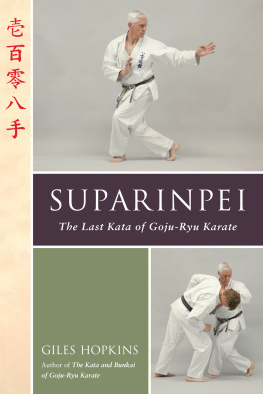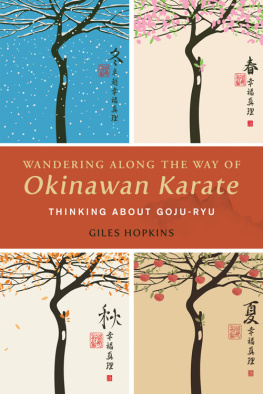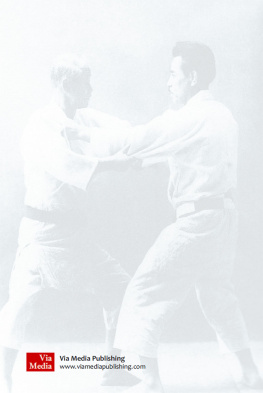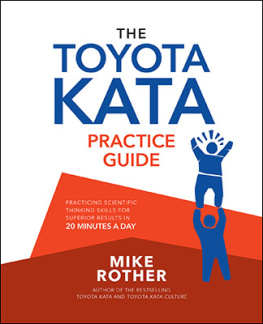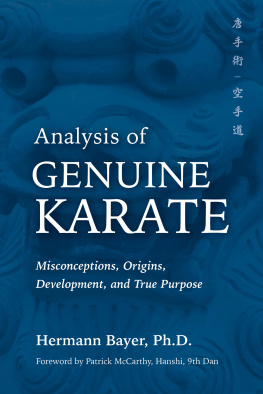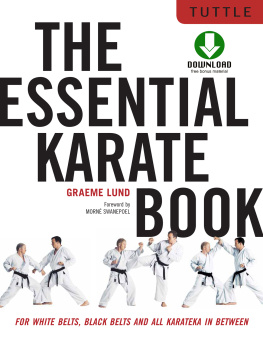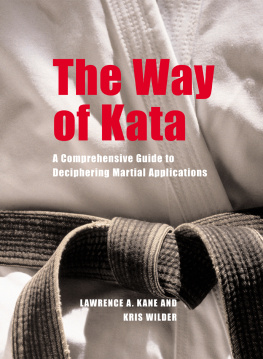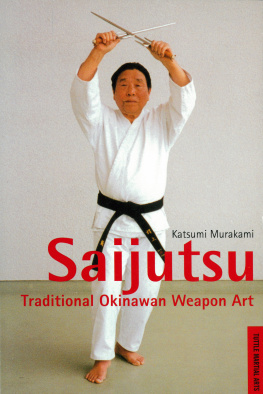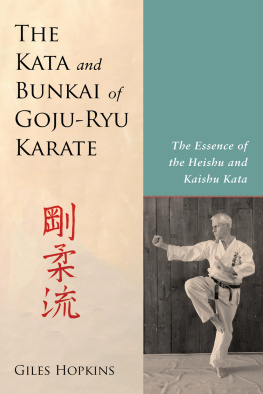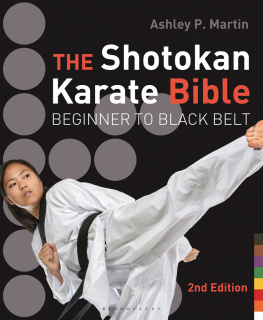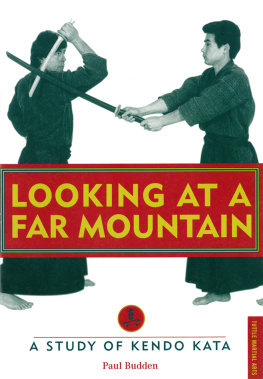
Copyright 2021 by Giles Hopkins. All rights reserved. No portion of this book, except for brief review, may be reproduced, stored in a retrieval system, or transmitted in any form or by any meanselectronic, mechanical, photocopying, recording, or otherwisewithout written permission of the publisher. For information contact Blue Snake Books c/o North Atlantic Books.
Published by Blue Snake Books, an imprint of North Atlantic Books
Berkeley, California
Cover and interior photos by Jeff Cook
Cover design by Howie Severson
Book design by Happenstance Type-O-Rama
Suparinpei: The Last Kata of Goju-Ryu Karate is sponsored and published by the Society for the Study of Native Arts and Sciences (dba North Atlantic Books), an educational nonprofit based in Berkeley, California, that collaborates with partners to develop cross-cultural perspectives, nurture holistic views of art, science, the humanities, and healing, and seed personal and global transformation by publishing work on the relationship of body, spirit, and nature.
North Atlantic Books publications are distributed to the US trade and internationally by Penguin Random House Publishers Services. For further information, visit our website at www.northatlanticbooks.com.
PLEASE NOTE: The creators and publishers of this book disclaim any liabilities for loss in connection with following any of the practices, exercises, and advice contained herein. To reduce the chance of injury or any other harm, the reader should consult a professional before undertaking this or any other martial arts, movement, meditative arts, health, or exercise program. The instructions and advice printed in this book are not in any way intended as a substitute for medical, mental, or emotional counseling with a licensed physician or healthcare provider.
Library of Congress Cataloging-in-Publication Data
Names: Hopkins, Giles, 1951 author.
Title: Suparinpei : the last kata of Goju-ryu Karate / Giles Hopkins.
Description: Berkeley, California : Blue Snake Books, 2021. | Includes
index. | Summary: An illustrated step-by-step guide to the structure,
themes, and techniques of Suparinpeithe last kata of Goju-ryu.
Suparinpei, or Pechurin, is the final and most difficult kata in the
Goju-ryu system of Okinawan karate. Its performance has long been
reserved for high-level practitioners, its history and applications
obscured by misunderstanding and misinterpretationProvided by
publisher.
Identifiers: LCCN 2020043118 (print) | LCCN 2020043119 (ebook) | ISBN
9781623175580 (Paperback) | ISBN 9781623175597 (ePub)
Subjects: LCSH: KarateJapanOkinawa Island. | Martial
artsJapanOkinawa. | Hand-to-hand fighting, Oriental. | Suparinpei.
Classification: LCC GV1114.3 .H664 2021 (print) | LCC GV1114.3 (ebook) |
DDC 796.815/30952294dc23
LC record available at https://lccn.loc.gov/2020043118
LC ebook record available at https://lccn.loc.gov/2020043119
To Kimo sensei, who first taught me Suparinpei
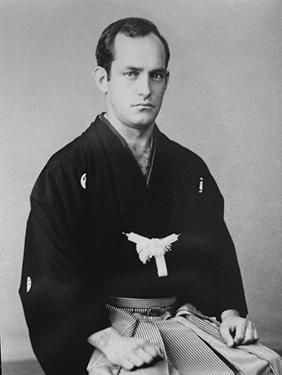
Kimo Wall sensei
Also by Giles Hopkins
- Wandering Along the Way of Okinawan Karate
- The Kata and Bunkai of Goju-Ryu Karate
Acknowledgments
I would like to extend my thanks and appreciation to my teachers, Kimo Wall, Gibo Seiki, and Matayoshi Shinpo, and also to my indispensable training partner and friend, Bill Diggle.
I would also like to thank Jeff Cook, who took most of the photographs for this book, and my son, Noah, who assisted me with the two-person application photographs.
I want to thank the editors at Blue Snake Books for their help and patience with a difficult task, helping me to translate a movement art into words and pictures.
And lastly, of course, I would like to thank my family: Martha, Emily, Phoebe, and Noah. I couldnt do any of this without all of you.
Preface
After the publication of my first book, The Kata and Bunkai of Goju-Ryu Karate, someone suggested that it would have been better if I had illustrated all the techniques of each of the classical kata, but that book would have been thousands of pages long. This book is my compromise. I have tried to illustrate one complete kata here, Suparinpei, the last kata of Goju-ryu, and explain each of the applications. Of course, there are always constraints. No book, however well-intentioned, can take the place of a teacher. My intention in this book is not so much to teach the kata to someone who doesnt know it, but to shed light on a single enigmatic kata, and thereby, hopefully, deepen our collective understanding of Okinawan Goju-ryu karate.
Some years ago, I sat down to leaf through a book on Tai Chi, where the author wrote what I think is a very telling summation of how many people nowadays approach kata and the martial arts in general. I am not one of those teachers, he said, who thinks that the actual physical movements of the form are to be used, as they stand, for self-defense. Rather, he argued, we study the form in order to learn the principles. I think he is probably in good company. There are many practitioners of Okinawan karate, having long ago given up on the idea that kata can be deciphered or that these mysterious movements even have meaning in any martial sense, who subscribe to the notion that you can practice the skills and principles of kata without knowing how the movements were originally intended to be applied.
While it may be true, at least in a martial sense, that the aim of kata study is to understand the principles, its certainly a stretch to imagine that we can discern the principles of any given system without first knowing how the seemingly arcane movements of kata were meant to be applied. The kata were created to preserve these principles of self-defense and teach them by showing examples of how to use them against an opponent. We can certainly practice generic principles, pound on the makiwara (punching post), and walk around the dojo holding the nigiri game (gripping jars), but the principles of any given system are contained within the applications of the techniques that are found in the kata or forms of that system. We can practice using the waist (koshi) or rooting or keeping the elbows down, but if we dont know how to use the techniques of the katahow the techniques were originally meant to be appliedwe wont understand why these things are important or why they are principles of the system we are practicing. Nor will we even begin to understand some of the principles that can only be grasped with a thorough understanding of the applications of kata. To imagine that we can learn the principles without knowing the applications seems to me as mistaken as putting the all too familiar cart before the horse.
It has always seemed a bit backward to me to suggest that the principles, or skills, as some refer to them, are the first things one should learn, only to be applied to the techniques of kata much later. How do you know that the principles you have come up with are the principles that derive from the system you are training unless you know how the techniques of that system are actually applied (bunkai), or to put it another way, how the movements of a given kata were originally meant to be used? And yet there are many that would say that it isnt possible to discover how the movements of kata were originally meant to be applied. The kata are too old and they were created too long ago, they say. Everything changes over time, and kata has no doubt changed too. But this is a rather pessimistic view, it seems to me. If we were simply to throw our hands up in resignation every time we encountered a puzzle, we might as well abandon science and bury our heads in the sandpile of discarded belief systems.
Next page
